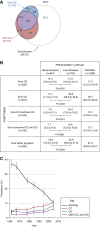The Presence of Chronic Mucus Hypersecretion across Adult Life in Relation to Chronic Obstructive Pulmonary Disease Development
- PMID: 26695373
- PMCID: PMC4824943
- DOI: 10.1164/rccm.201511-2210OC
The Presence of Chronic Mucus Hypersecretion across Adult Life in Relation to Chronic Obstructive Pulmonary Disease Development
Abstract
Rationale: Chronic mucus hypersecretion (CMH) is common among smokers and is associated with chronic obstructive pulmonary disease development and progression.
Objectives: To understand how the relationships between smoking, CMH, and chronic obstructive pulmonary disease develop during adult life, and facilitate earlier disease detection and intervention.
Methods: We analyzed data on CMH, smoking, and lung function prospectively collected by the Medical Research Council National Survey of Health and Development, a nationally representative British cohort followed since birth in 1946. We analyzed the longitudinal relationships between smoking and CMH, how symptoms during life related to airflow limitation at 60-64 years, and how CMH duration between ages 43 and 60-64 years related to concurrent FEV1 decline.
Measurements and main results: From 5,362 individuals enrolled at birth, 4,427 contributed data between ages 20 and 64 years (52% male; 63% ever-smoker). Among smokers CMH prevalence escalated between ages 36 and 43 from 7.6 ± 2.0% to 13.0 ± 2.6%. At these ages, symptoms were associated with a higher risk of subsequent airflow limitation (odds ratio [95% confidence interval], 3.70 [1.62-8.45] and 4.11 [1.85-9.13], respectively). Across adult life, CMH followed a dynamic remitting-relapsing course. Symptom prevalence following smoking cessation returned to levels seen among never-smokers. The longer CMH was present across three occasions (ages 43, 53, and 60-64 yr), the greater the concurrent FEV1 decline, corresponding to an additional decrement of 3.6 ± 2.5 ml/yr per occasion that CMH was present (P = 0.005).
Conclusions: CMH among middle-aged smokers represents an early developmental phase of chronic obstructive pulmonary disease. Smoking-related CMH usually resolves following smoking cessation but the longer its duration the greater the FEV1 lost, suggesting the course of CMH across adult life may reflect the underlying course of airway disease activity.
Keywords: COPD; chronic bronchitis; chronic mucus hypersecretion; cough; smoking.
Figures






Comment in
-
Chronic Mucus Hypersecretion and the Natural History of Chronic Obstructive Pulmonary Disease.Am J Respir Crit Care Med. 2016 Mar 15;193(6):602-3. doi: 10.1164/rccm.201601-0001ED. Am J Respir Crit Care Med. 2016. PMID: 26977967 No abstract available.
References
-
- Fletcher CM. The Natural history of chronic bronchitis and emphysema: an eight-year study of early chronic obstructive lung disease in working men in London. Oxford: Oxford University Press; 1976.
-
- Kanner RE, Connett JE, Williams DE, Buist AS. Effects of randomized assignment to a smoking cessation intervention and changes in smoking habits on respiratory symptoms in smokers with early chronic obstructive pulmonary disease: the Lung Health Study. Am J Med. 1999;106:410–416. - PubMed
-
- Pelkonen M, Notkola IL, Nissinen A, Tukiainen H, Koskela H. Thirty-year cumulative incidence of chronic bronchitis and COPD in relation to 30-year pulmonary function and 40-year mortality: a follow-up in middle-aged rural men. Chest. 2006;130:1129–1137. - PubMed
-
- Lindberg A, Jonsson AC, Rönmark E, Lundgren R, Larsson LG, Lundbäck B. Ten-year cumulative incidence of COPD and risk factors for incident disease in a symptomatic cohort. Chest. 2005;127:1544–1552. - PubMed
Publication types
MeSH terms
Grants and funding
LinkOut - more resources
Full Text Sources
Other Literature Sources
Medical

